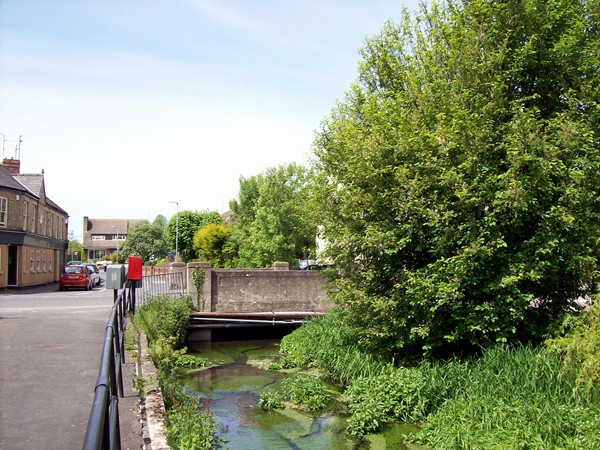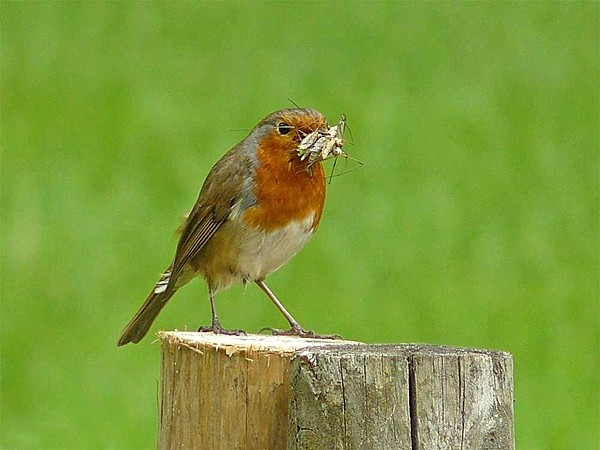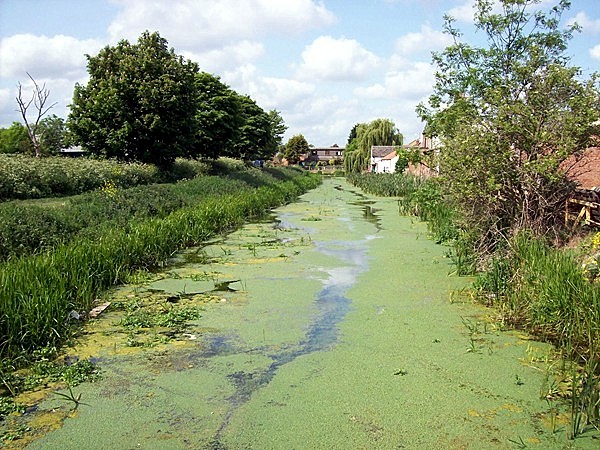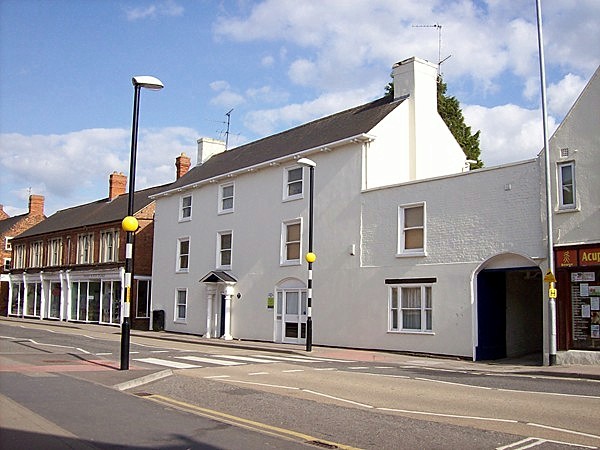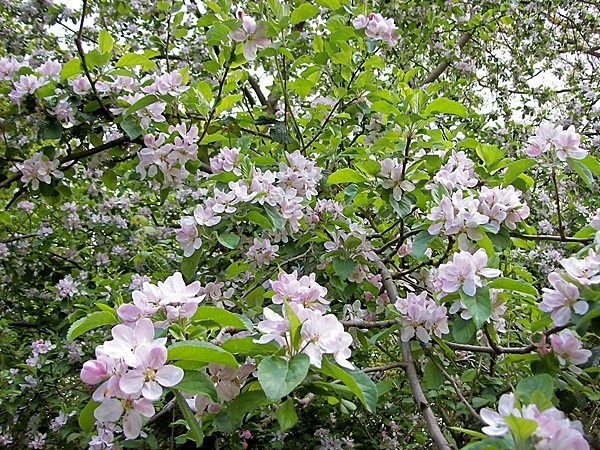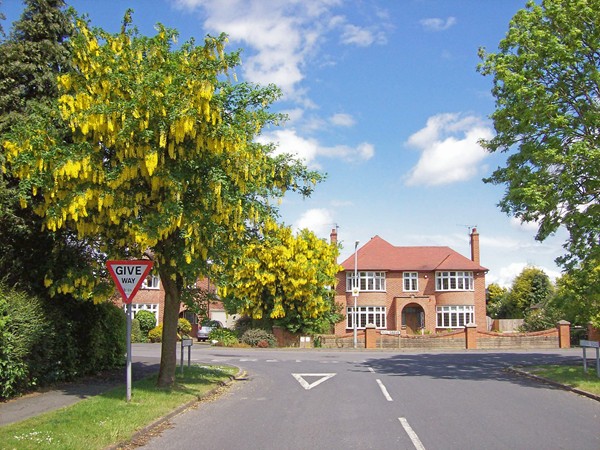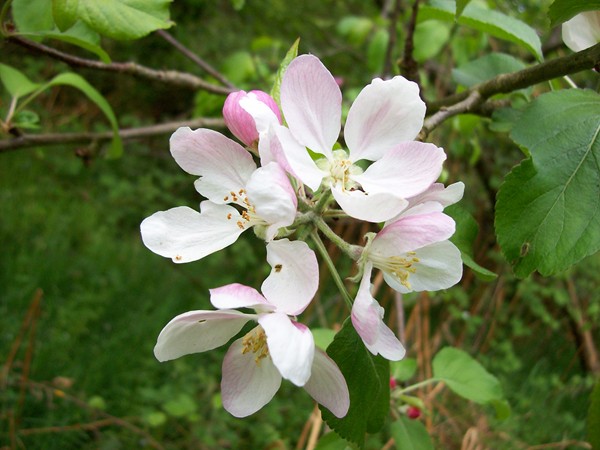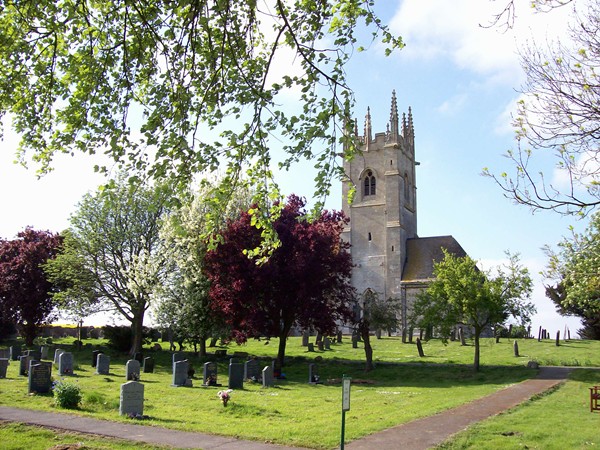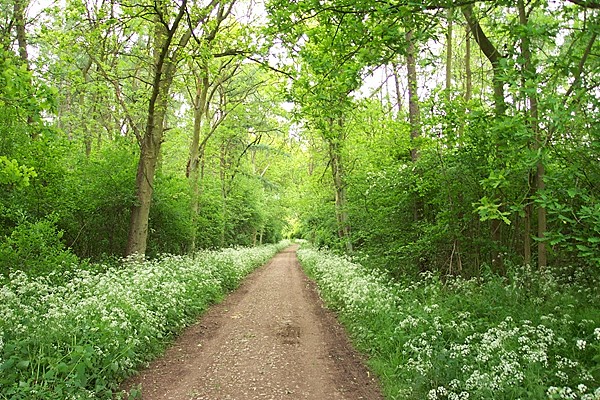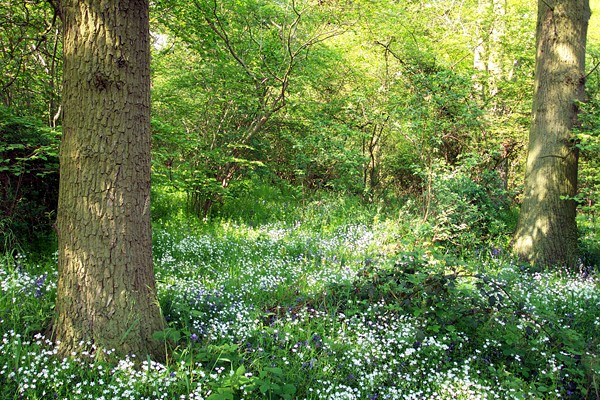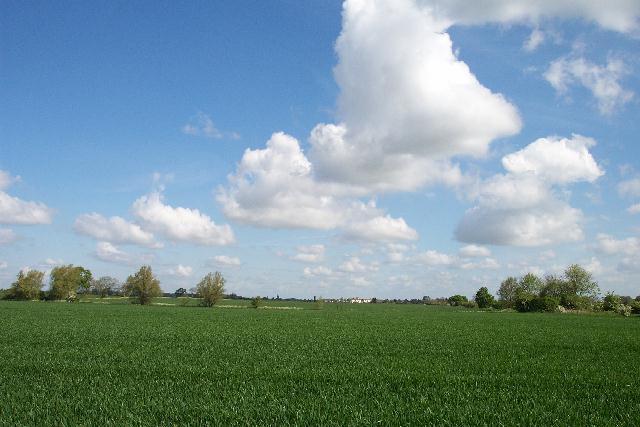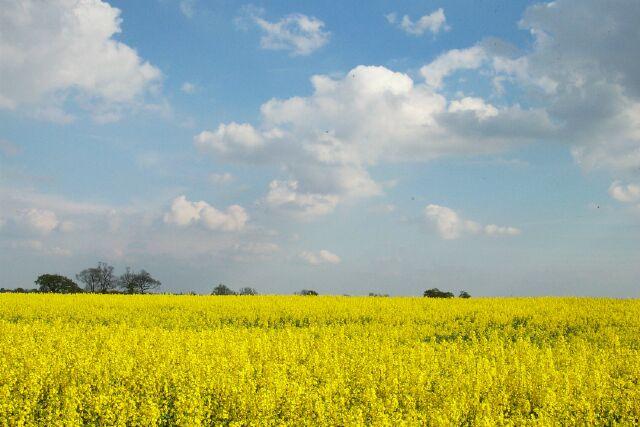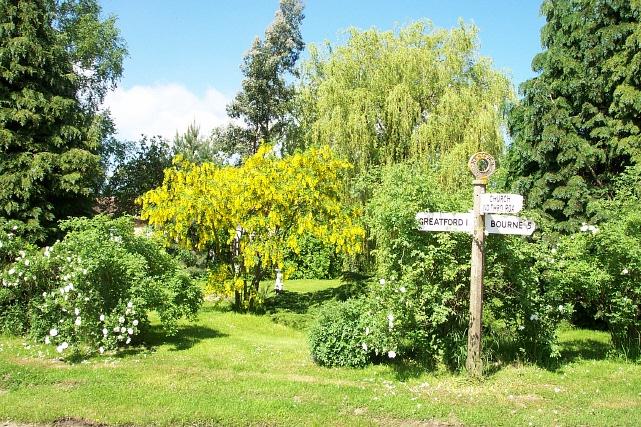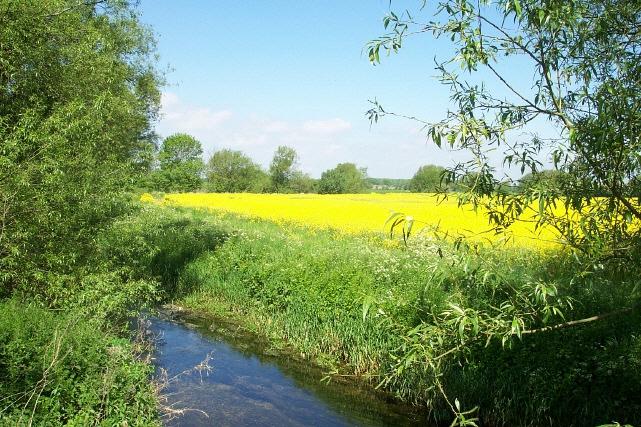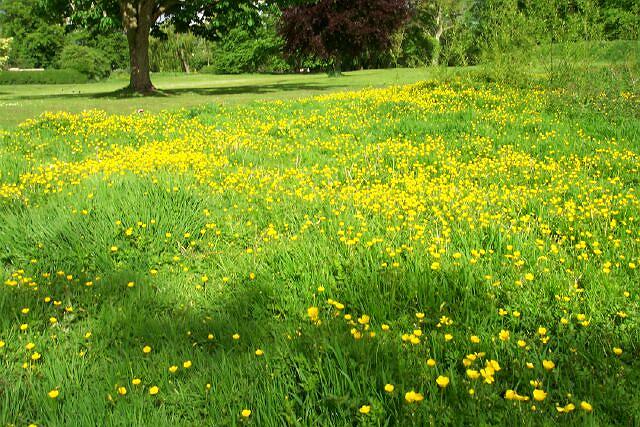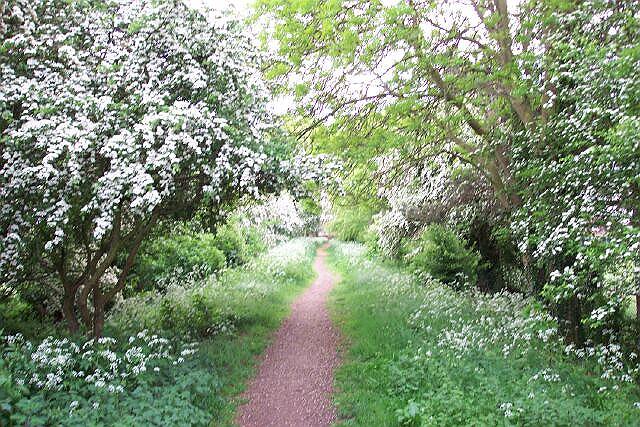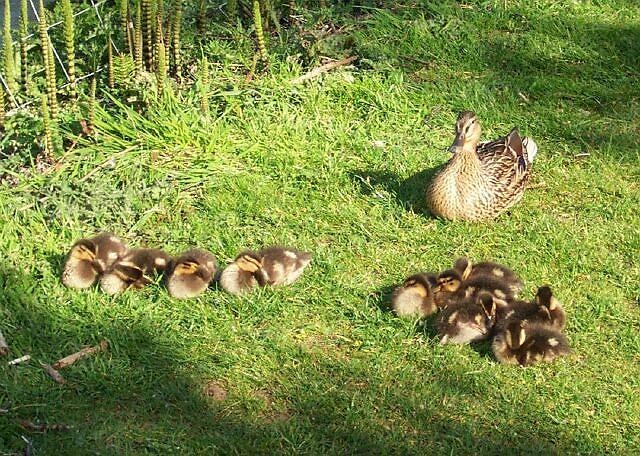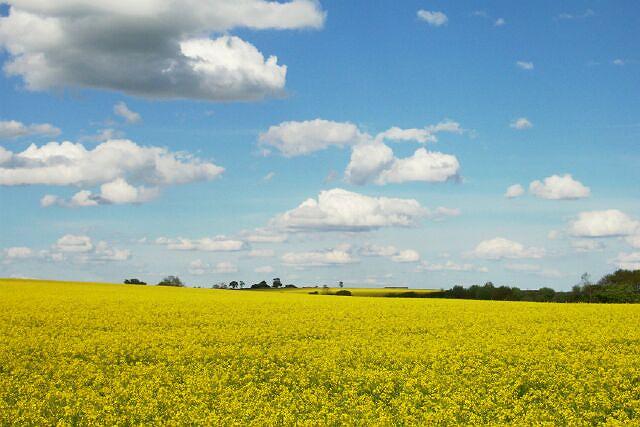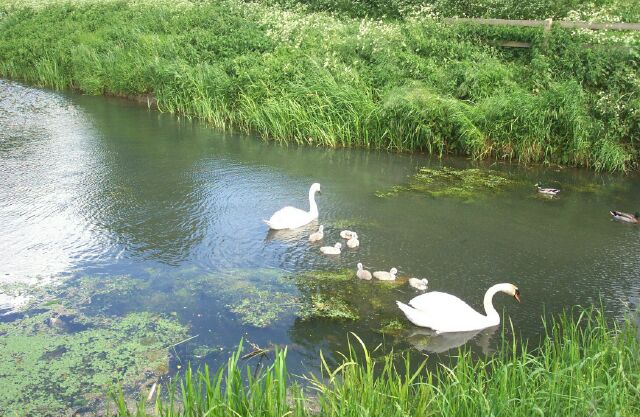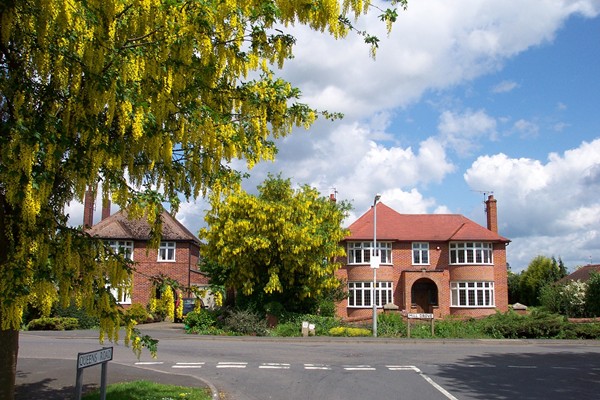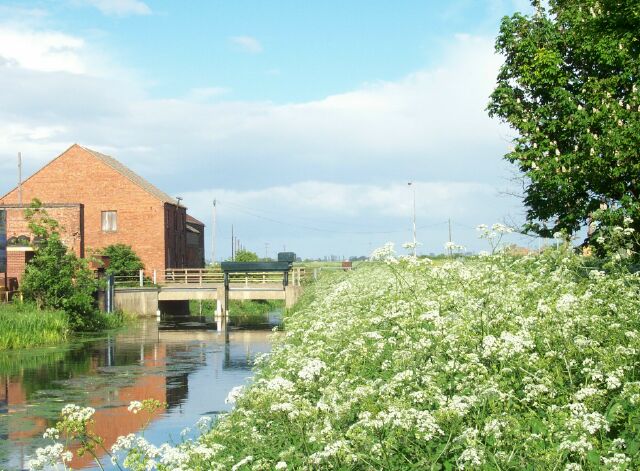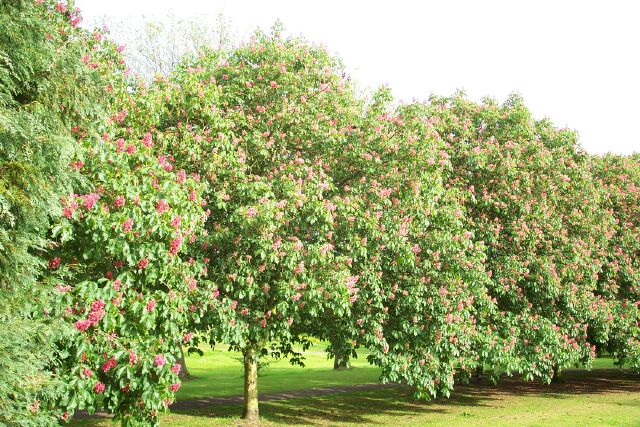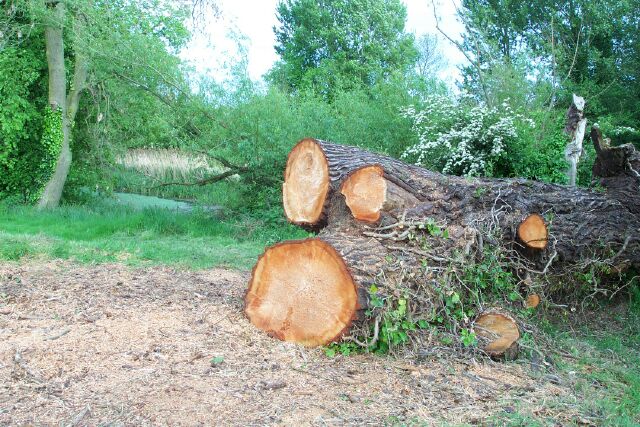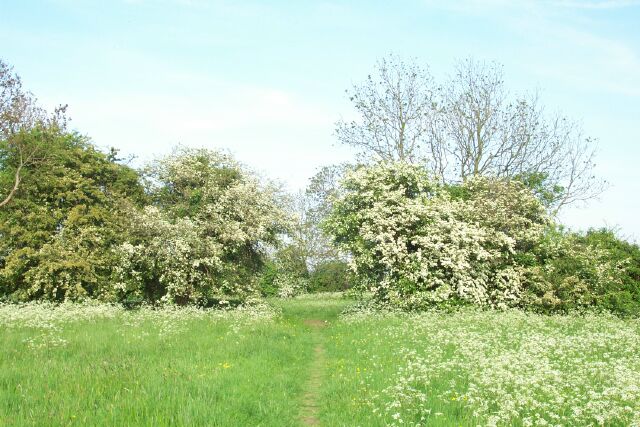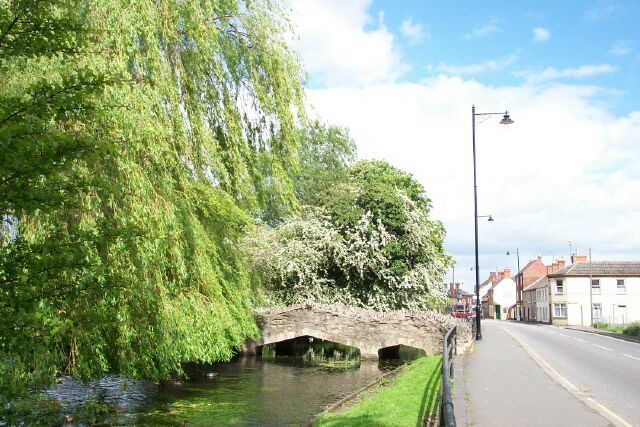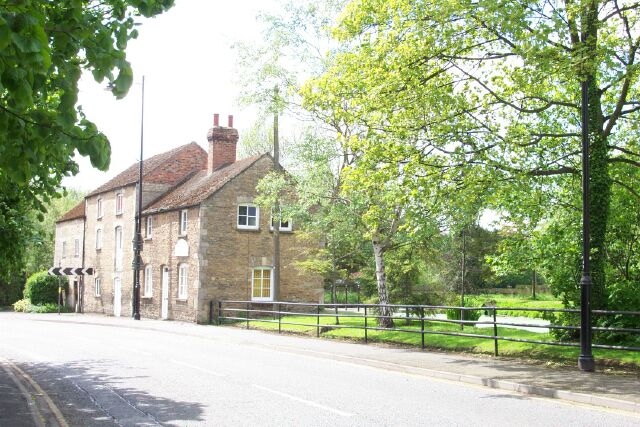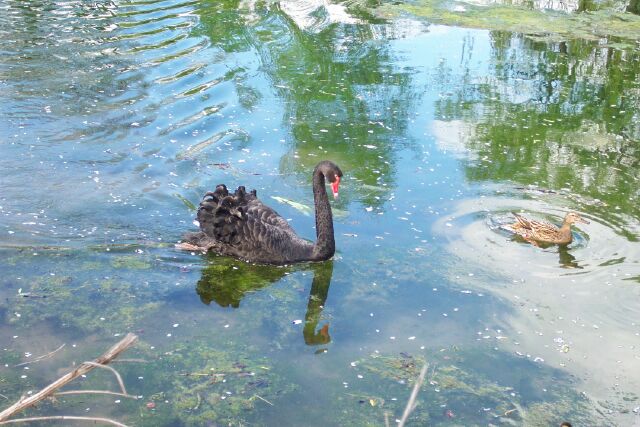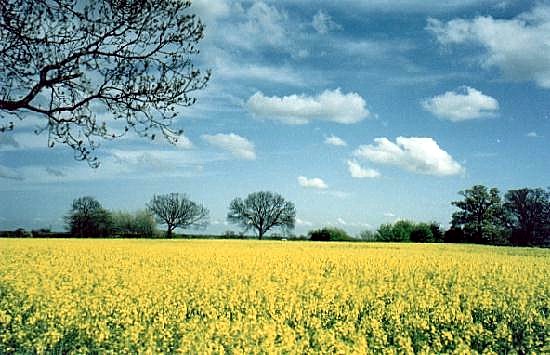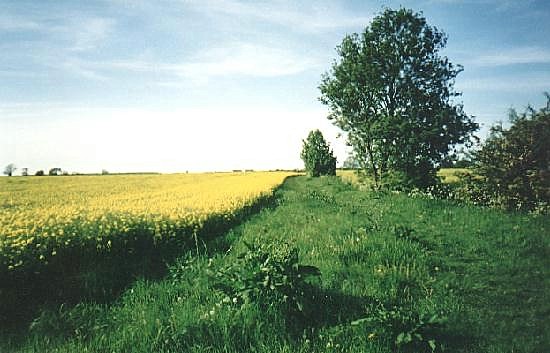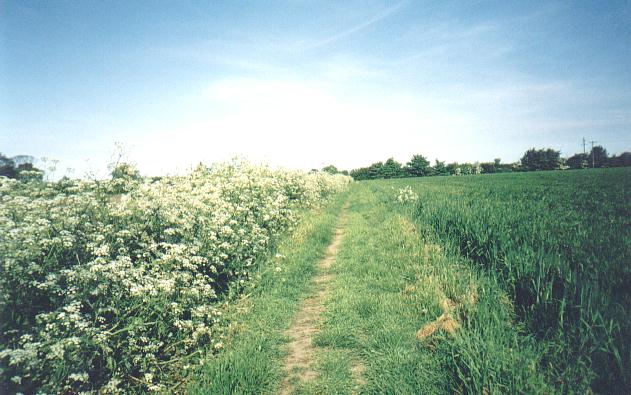|
May
Wednesday 14th May 2014: The Stephenson Way development on the edge of the fen to the north of Bourne was built on open fields during the early 1970s alongside the site of the old railway line to Sleaford, hence the name, when planners observed the concept of maintaining the appearance of the greenbelt within the built up area, thus providing each detached house with plenty of space both front and back, grassy verges along the roads and a variety of ornamental trees in the gardens to brighten up the new urban landscape. These trees have long since reached maturity and provide a galaxy of colour each spring making this residential estate one of the most attractive and highly sought after locations in the town.
Sunday 26th May 2013: Eastgate has become one of the most neglected areas of the town in recent years and the Bourne Eau which runs through has been in particular need of attention, the banks overgrown and the waterway itself choked with weeds. The road crosses the river on an old concrete bridge whose appearance belies its age, dating from the early 19th century and known as the Queen’s Bridge. The structure has little architectural appeal and is soon to disappear, victim of a European Union directive because its official weight capacity of 7.5 tonnes is below the required 40 tonne limit and so Lincolnshire County Council, the highways authority, will be replacing it during the summer months.
Monday 13th May 2013: We are in the middle of the nesting season for our wild birds and the signs of this annual activity are everywhere, particularly in Bourne Wood where this robin was spotted on Monday already busy feeding a growing family. This is probably the most popular of our native species although the bright orange-red breast, brown back and dumpy shape is a more familiar sight in the back garden throughout the winter months but they can be seen just as often in spring and summer and they are the only ones that sing all year round. Their usual diet is worms, seeds, fruits and insects and this little bundle of tasty morsels that has just been collected is obviously going to feed a few hungry mouths in a nearby nest.
Tuesday 31st May 2011: The graveyard adjoining the Abbey Church has been neglected in recent years and because the grass is mown infrequently, there are many weeds, particularly nettles, ivy growing over tombstones and even a self-setter elder tree sprouting near one of them. Visitors are always surprised that although the interior of the 12th century building is kept in such good order, little attention is paid to the outside but all that may be about to change because volunteers are being recruited to tidy up God's little acre which will be on the route taken by the judges for the annual Bourne in Bloom competition later this summer.
Thursday 19th May 2011: The Bourne Eau is one of the town's biggest assets but also its most neglected. This was a vital link for trade in past times, with cargo boats plying between here and the east coast ports, and even an attraction for leisure pursuits such as boating and fishing, but over the past century its appeal has been lost, the surface choked with algae and rubbish and the banks overgrown with reeds and weeds. The river has been completely forgotten by our local authorities and the only chance of realising its full potential is with an enterprising investor who might wish to transform this spot into a major waterside development.
Sunday 16th May 2010: The best time to explore the town centre is late on a Sunday afternoon when you are likely to have the streets to yourself and ample opportunity to give the buildings a closer look without being jostled on the pavements or endangered by passing traffic. Saxonhurst House was built as a gentlemen's residence in the late 18th century with an interesting doorcase of Doric columns and the coaching entrance to the stables still in evidence. It is now used by the registrar for births, marriages and deaths while the upstairs room have been converted into flats.
Thursday 13th May 2010: We found the apple blossom in bloom today alongside the main path in Bourne Wood, not from the usual crab apple but the cultivated variety found in gardens and orchards, seeded perhaps from a core thrown away by walkers and picnickers in years past. This blossom is always a welcome sign of spring, although fleeting and stays only a few days, but is most delicate and fragrant for those who manage to spot it just a few feet away from the main path yet barely noticed by the many visitors who pass this way.
Thursday 21st May 2009: It is impossible to drive past this spot at the junction of Queen's Road and Mill Drove on a sunny day in May without taking a photograph and this morning conditions were just right with a blue sky and scudding cumulus clouds that set the seal on a good picture. I was only just in time because the blossom was already beginning to fall and the scene would have been quite different in another day or two.
Saturday 31st May 2008: The Wellhead Gardens are full of weeping willows which line the banks of the Bourne Eau, a tree that thrives in damp places such as this, but these specimens have been here for almost a century and many have become top heavy, the canopy and lower branches becoming too much a weight for the trunk to bear. After several days of heavy rain, the soil has become soft and unable to sustain the stability required and so the tree roots sink and the heaviest branches collapse. This particular willow overlooks South Street but another on the other side of the gardens collapsed completely during this spell of wet weather. The solution is more care for these trees, particularly seasonal pruning and the removal of lower branches at the first signs of danger.
Thursday 29th May 2008: Doctors reminded us this week that the best exercise is a stroll in the countryside because the secret ingredient is greenery and most of us, especially those who live in towns and cities, do not get enough of it. The result can make us irritable, depressed and even physical ill yet, say the medical experts, put us in contact with trees and grass and levels of stress fall away. Nature deficit disorder may not be a recognised clinical condition but those who rarely step out into the great outdoors are unlikely to be healthy and are missing out on a most pleasurable experience. Here in Bourne, we have no excuse in not making it a regular date because we have more than 400 acres of woodland on our doorstep and at this time of the year it is lush green from end to end. Go and take a look.
Monday 7th May 2007: There are several apple trees in Bourne Wood, not the usual crab apples, but the cultivated variety that you find in gardens and orchards, seeded perhaps from cores thrown away by walkers and picnickers in years past. Their blossom, always a welcome sign of spring, is fleeting, staying only a few days, but is also the most beautiful and fragrant for those who manage to see it. We found this on Bank Holiday Monday just a few feet away from the main path yet barely noticed by the many visitors who passed this way and I suppose that the fruit it will produce must now be regarded as wild apples but they do not last long and are quickly picked by passers-by as soon as they are ready.
Thursday 3rd May 2007: The name of Sempringham was once known throughout the land but is now a difficult place to find, situated at the end of a lonely farm road in the middle of a prairie of oil seed crops, seven miles north of Bourne, but the trip is well worthwhile. There is now no trace of the famous priory founded by the crippled priest St Gilbert in 1139 that attracted visitors here in times past although St Andrew's Church, perched on a rise and of later origins, is a delight while the churchyard itself is among the best kept in South Lincolnshire. There are many things to see apart from the mainly 14th century building, including a holy well and shrines to the captive nun Princess Gwenllian, the last true-born Princess of Wales, who was held captive here for more than half a century.
Wednesday 24th May 2006:A weather pattern of rain and warm sunshine has produced an abundant display of cow parsley this spring and the roads and lanes are lined with walls of white with the pungent bitter sweet smell from its blossom wafting in through the windows of the car as you drive by. In Bourne Wood it can be found alongside most of the main paths where it stands out against the lush green undergrowth. This plant is so common that most regard it as a weed that is quickly disposed of when it appears in parks and cultivated plots yet if it were less prolific, even rare, then the world's gardeners would be willing to pay high prices for specimens to adorn their herbaceous borders.
Thursday 11th May 2006:
The bluebells for which Dole Wood, near Bourne, has become famous have all
but disappeared this year and they are rapidly being replaced by the white
flowers of the greater stitchwort that is carpeting the floor amid a
luxurious growth of green grass as part of the cycle of springtime. This
was once part of an ancient forest but is now a small and isolated
woodland oasis amid a desert of intensive farming, surrounded by green
corn and the yellow blossom of oilseed crops. The wood is small and
circular with a perimeter track that you can walk easily in under half an
hour and it is well worth a visit because of its peace and tranquillity
with only birdsong and the buzz of insects for company. Wednesday 18th May 2005: The fields of growing wheat we see in the countryside during May are a testament to modern farming practices that do not allow a single plant to grow in their midst. In the process, agro-chemicals have killed off many of our wild flowers that once brought a colour and beauty to the England landscape. Here and there, on isolated roadside verges, outside the farm gate and at the field's edge where they have escaped the poisonous herbicide sprays, clumps of our native flora can be seen struggling to survive against these intensive agricultural practices and the isolated primroses and cowslips, poppies and daisies, act as a reminder of the way it was. The intense colour of the green corn has a beauty that should not be dismissed, often stretching to the far horizon such as here in the fields between Bourne and Dyke village, but they have a conformity about them that reeks of productivity and profit and they also serve as a reminder that the land may not be able to withstand this assault on its abundance indefinitely.
Sunday 1st May 2005: Crops of oil seed can be seen in abundance around Bourne at this time of the year, huge swathes of yellow blossom stretching to the horizon and beyond, the pungent but not unpleasant smell wafting in through the car windows as you drive by. Some believe that the sight of oil seed is garish and totally out of place in a traditional English landscape and although it may be unfamiliar, it has in fact been with us for a very long time, notably during the 17th century when the oil it produced was used by Dutch engineers who came here to drain the fens to lubricate their pumps. In recent years, the acreage has increased to meet the demand for an edible oil as a home-grown alternative to groundnuts and soya. We found this crop in a field on the outskirts of Thurlby, two miles south of Bourne, but it has now become popular with farmers because the revenue from a good harvest when the seed is sold to the crushing mills for conversion into vegetable oil can exceed that of wheat and barley.
Friday 27th May 2004: The signposts of yesteryear are fast disappearing and most have already gone from urban areas although those in the countryside cling on as a reminder of a quieter and less hurried age. Until recent years, they were replaced with modern steel columns as a matter of routine until some enlightened local authorities realised that part of our heritage was being consigned to the dustbin each time a traditional finger post was taken down and here in South Lincolnshire there is a concerted effort to preserve those items of street furniture that have some history. This sign can be found nestling amid a landscaped splendour in the centre of Braceborough village, five miles south of Bourne, and dates from the early years of the 20th century, bearing the imprint of Kesteven County Council which administered the highways in this part of South Lincolnshire from Victorian times until 1974 when its affairs were taken over by the present authority, Lincolnshire County Council.
Wednesday 19th May 2004: The countryside has turned a lush green as springtime advances and many of the fields are splashed with yellow as more farmers grow oil seed in preference to cereals. The blossom is colourful and the smell pungent as you drive by, a hazard for asthma and hay fever sufferers, and so the crop is not popular with everyone. I found this field in full bloom alongside the East Glen River where it crosses the main road on the outskirts of Braceborough village, five miles south of Bourne, and the view in all directions was so breathtaking that I stayed there for some time, leaning on the rail of the river bridge while enjoying it to the full.
Monday 19th May 2003: So many of our wild flowers have disappeared through the use of agro-chemicals and intensive farming practices that it is a sheer delight to see them in large numbers. Buttercups (Rananculus acris) are one of the most familiar of our summer flowers and they abound in pastures everywhere, along roadside verges and at the field's edge where they have escaped the deadly herbicide sprays. These have become an annual feature of a marshy area near to St Peter's Pool in the Wellhead Gardens at Bourne where the ground is so damp that it has escaped the mowing machines that keep the park in trim and this is the result. The rich yellow of these cup-shaped flowers is associated in folklore with the yellow butter from the cattle that graze the fields where they grow and who has not, in their youth, held one under the chin of their companion to discover whether this yellow is reflected on the skin, an experiment that is reputed to be a sure sign that they like butter if it does.
Tuesday 13th May 2003: The May blossom is at its very best this year, the most prolific showing that we have seen since moving to Bourne twenty years ago. Wherever you walk, the air is redolent with its bitter sweet smell and the hawthorn trees hang heavy with their white blossom. Among the best places to see it is alongside the footpath which follows the route of the old railway line which ran between Bourne and Sleaford but closed in 1964, and as the corridor of land has been left practically untouched, it has become a small haven for wildlife. The May blossom cascades from the trees on both sides of the path and once having walked its length, we retraced our steps and went back again because it was such a glorious sight. My mother would never allow the frothy white sprays to enter the house because May blossom was thought to be unlucky. The reason for this superstition has been lost but it no doubt has some pre-Christian significance or perhaps our ancestors may have associated the coming of the plague with this time of the year, but whatever the cause, such ill-omen has no place in our reckoning when we see these beautiful blooms today.
Tuesday 6th May 2003: St Peter's Pool is full of wildfowl with their young at this time of the year and among the most numerous is the mallard (Anas platyrhynchos), a common dabbling duck that flocks here and along the Bourne Eau in large numbers. Although not exactly domesticated, they have become quite tame and visitors arrive here most days with morsels of bread and cake to feed them, especially if they have half a dozen young in tow which is usually the case at this time of the year. These ducks breed here regularly and some have been sitting on clutches on 11 or 12 olive grey eggs in safe nesting places nearby, under a hedge or in a tree hole, but not all hatch out and some fall prey to predators. Nevertheless, large families are quite normal and today we were lucky because we found one female was sitting proudly on the bank and basking in a late afternoon shaft of sunlight with her brood of ten lined up in front of her, as though putting them on public display, and although they are usually very protective birds, she made no move when I crept closer to take this shot.
Monday 5th May 2003: We went out for a drive into the countryside late this afternoon, looking for a suitable field of oilseed to photograph. Many people dislike the yellow blossom that has become such a common sight at this time of the year but we find it an attractive addition to the springtime colours while the scent is very pleasant, although it can be overwhelming if you go too close. We eventually found this crop to the north east of Bourne, on the road between Keisby and Kirkby Underwood, and it was a suitable field to photograph because it sloped upwards towards the horizon. The sky was also full of scudding cumulus clouds but the sun was playing hide and seek and we waited for some time before it appeared and enabled me to capture a suitable shot.
Tuesday 28th May 2002: The Bourne Eau where it runs behind Eastgate has been home to a pair of mute swans for the past ten years and I go there frequently to check on their progress and to photograph them when they are co-operative, a difficult assignment because although these birds are reasonably friendly, they are not always tempted by bread and other morsels that I have used to entice them within range of my camera lens. This year they have proved to be particularly difficult because they are coping with seven cygnets, although nine were hatched out from this year's clutch of eggs but two fell victim to predators. The swans are therefore wary when anyone gets too near and pointing a camera at them from a close distance during their most intimate moments falls into this category. This is the best shot of a dozen that I managed to get when I found the family out for an early evening forage among the algae in the river where it joins the Car Dyke near Bedehouse Bank, which is one of their favourite spots, but if you are thinking of seeking them out for yourself, take care, because an angry pen, the more dangerous of the two, can break your arm with the flap of its wing.
Friday 24th May 2002: The prettiest road in Bourne, especially in springtime, is undoubtedly Mill Drove, one of the town's more recent residential developments which was planted with a variety of trees that can be seen at their best at this time of the year. Laburnum was a popular choice, as it was for the adjoining Queen's Road, and here at the junction of the two streets, their flowers provide a splash of colour against the red brick and tile of the large house built by local farmer and landowner Mr Len Pick in 1951. The common laburnum (Laburnum anagyroides) grows wild in the woods and thickets in the mountainous regions of southern and central Europe but here in England it has been widely planted as an ornamental tree and was much favoured by local authorities and so it can frequently be found in parks and gardens and at the roadside in urban areas. The bright yellow flowers in long, loose, drooping chains, are a delight in springtime but the laburnum does have one drawback in that all parts of the tree, especially the seeds, are poisonous and so it is being planted less in public places today than it was in years past.
Wednesday 22nd May 2002: The weather conditions this year have been ideal for cow parsley which thrives on sunshine and showers in damp places such as roadside verges and river banks. It is easily recognised by its pungent smell and ubiquitous habits because it forms the walls of white that flank many a country lane and footpath in springtime. Several other species are rather similar but cow parsley (Anthriscus sylvestris) is the earliest and most common, a tall and slightly downy plant with a hollow stem that was a favoured raw material for making peashooters in my boyhood, a practice frowned upon by my mother because the plant was also reckoned to have diuretic properties. It flowers from April to June and there are many places around the town where it can be found, particularly here on the banks of the Bourne Eau behind Eastgate, downstream from its junction with the Car Dyke, with the old riverside warehouses and the Mays Sluice ahead and then a clear view out into the fen where you will find even more cow parsley in abundance.
Monday 20th May 2002: The Wellhead Gardens in Bourne are best known for their ornamental cherry trees that flower so colourfully in April and provide a magical walk along the main path overhung with white and pink blossom. But another avenue in the park, to the north east and leading into West Street, is equally attractive because it is lined with horse chestnut trees that bloom with a mass of red candles that appear during May. This tree is a hybrid between our own native horse chestnut and the American red buckeye and is widely planted throughout Britain as an ornamental species. It reaches a height in excess of 60 feet and is a favourite for planting in public gardens and alongside roads and one of the best places to see it on a public highway is along the entrance road into Stamford from Bourne on the A6171. But the scarlet red blossom does not last long and if you wish to see it in the Wellhead Gardens then you must keep a weather eye on the candles and once they start to burst into life in mid-May, it is well worth the wait.
Sunday 19th May 2002: Trees in the Wellhead Gardens that were brought down by the gales in January last year have still not been cleared away. Many of the weeping willows are so large that they are taking the park staff many weeks to cut up and cart away. These trees have been a feature of the gardens for well over half a century and their sheer size is an indication of the strength of the winds when they were blown down. This one, on the banks of the Bourne Eau, almost at its source, has a trunk that is well over two feet across while some of the lower branches have an equally massive girth. The tree is being sawn up in sections, a piece at a time, and given away to visitors as garden features or even firewood, but the task is not expected to be completed for several months yet. See The Wellhead Gardens.
Thursday 16th May 2002: Today was the hottest day of the year so far and by mid-afternoon the temperature had soared to 80 degrees F. Our early evening walk took as along the route of the old railway line between Bourne and Dyke village, a wildlife corridor between arable fields that is fast becoming overgrown in places but is still used by those anxious to keep the footpath open. Leaving the track halfway down, we found ourselves in a small, narrow meadow with patches of buttercups and an abundance of cow parsley while the hedgerows were weighed down with May blossom and the strong scent pleasantly overwhelming. This strip has been left uncultivated for many years and so walkers can enjoy it but the use of agro-chemicals in past years has taken its toll and bitten deep into the soil for had this been the virgin grassland of past centuries, then it would have been ablaze with the colour of many other wild flowers today.
Wednesday 15th May 2002:This section of South Street where the river runs alongside the road is one of the prettiest parts of Bourne and a favourite place for mothers with children who come here to feed the ducks. The War Memorial Gardens are just over the stone bridge and beyond that the Wellhead Gardens, two of the town's great public assets because they provide a haven of peace and tranquilly just a short step from the town centre. The Bourne Eau has been devoid of fish, however, since a major pollution incident in 1960 when toxic effluent from a riverside industry killed off the entire population over a single weekend. But there is optimism for the future because shoals of minnows have been spotted along this section of the river at dusk, a sure sign that many species are breeding here and that the Bourne Eau may soon support a wide variety of coarse fish as it did in years past.
Tuesday 14th May 2002: The site for a proposed memorial to the motor racing pioneer Raymond Mays is this strip of grassland alongside Baldock's Mill, built beside the Bourne Eau in South Street in 1800 and one of the prettiest parts of this South Lincolnshire town. Plans for a six-foot high structure of brick and stone and adorned with racing motifs are currently under consideration by South Kesteven District Council but there have already been reservations about its size and location. The problem with the chosen site is that it lies next to a Grade II listed building surrounded by trees that are subject to preservation orders because of their visual importance and the council has a particular duty with regard to its deliberations in considering the impact that the structure will have on that building as well as on the street scene. An added difficulty is that the location is also within the town's Conservation Area designated in July 1977 and the Department for Environment (DEFRA) may have to be consulted before a final decision is made.
Friday 10th May 2002: The Red Hall is one of the oldest and certainly the most important secular building in Bourne and was constructed circa 1605 to designs by John Thorpe, the Elizabethan architect responsible for many similar houses in Lincolnshire and the East Midlands. The most popular view is of the front that can be seen off South Street but if you walk round to the left, there is another commanding aspect on the southern side, best viewed on a bright afternoon when the sun lights up the distinctive red brickwork which gives the building its name. Both of these pictures can be seen in the history of the Red Hall but at this time of the year you can get another entrancing view from the site of the old cress beds alongside the Wellhead Gardens where the hall is presented as a remote and mysterious building, the setting perhaps for a Gothic novel or period film drama. I took this picture a few days ago but by the end of the month, the hedge will have grown so thick that this view will be obscured until the late autumn.
Friday 3rd May 2002: We walk frequently in the Wellhead Gardens in the late afternoon and rarely leave without taking a look at St Peter's Pool and the progress of the pair of black swans that were introduced here in 1999, a gift to the town from the Wildfowl Trust. They are handsome birds, indigenous to Australia and Tasmania, and have bred many cygnets in their new habitat but once they are old enough the parents do not allow them to stay and they force them to fly off to other parts. This anti-social behaviour is not however confined to other wildfowl and they appear to live in harmony with the many moorhen and particularly mallard that live on the pool and, as we found this evening, often enjoy each other's company but then this particular breed of duck is extremely gregarious and very hard to dislike.
Thursday 17th May 2001: It is at this time of the year that large tracts of the English countryside turn a brilliant yellow as the oil seed crops burst into blossom. Oil seed (Brassica napus) has been grown in these parts since the 17th century when Dutch engineers who came to this country to help drain the fens used the oil it produced to lubricate their massive pumps and so the image of this product remained industrial until the latter half of the last century. Since then, the acreage has increased dramatically to produce an edible oil that is a home-grown alternative to groundnuts, sunflowers and soya, and a much favoured and healthier alternative for culinary purposes than rendered animal fats such as dripping and lard. I found this crop on the outskirts of Kirkby Underwood, five miles north of Bourne, although there are few roads hereabouts that you can drive along without coming across a field glowing with the glorious yellow of these plants while their pleasant and strong smelling scent wafts in through the car windows as you pass.
Monday 18th May 1998: This is one of our favourite footpaths, starting just off the A15 north of Bourne, and running alongside a field that was growing oilseed when I took this picture, while on the other side is a tributary of the Car Dyke, the ancient Roman waterway. We walk this delightful path about once a week in the spring and the circular route from our house in Stephenson Way and back is just over three miles, taking in a most attractive part of the rural landscape. England is truly a green and pleasant land and here you will find a typical fenland scene with a 360 degree view of the horizon, a changing sky and a stillness to intense that it makes you catch your breath. It is hard to believe that such peace and tranquillity can exist just a short distance from the town centre.
Thursday 21st May 1998: This is another section of the same footpath just off the A15 north of Bourne. It runs across the fields with a growing crop of green corn on the right and the path edged with cow parsley, one of the commonest plants to be found in the wild. It has white flowers with a pungent smell and grows thick and tall, often up to six feet in height, and can be found in the hedgerows and field edges where the flowers glow almost luminously on a bright, moonlit night. Cow parsley is regarded as a weed because it is so common but were it a rare plant, then it would adorn every back garden.
Go to: Main Index Villages Index |

